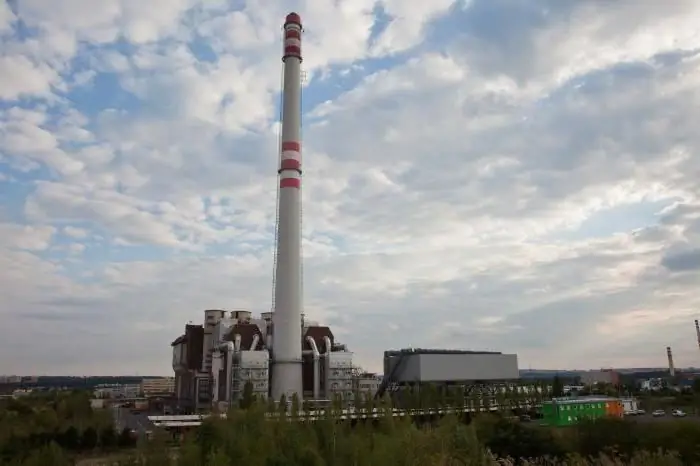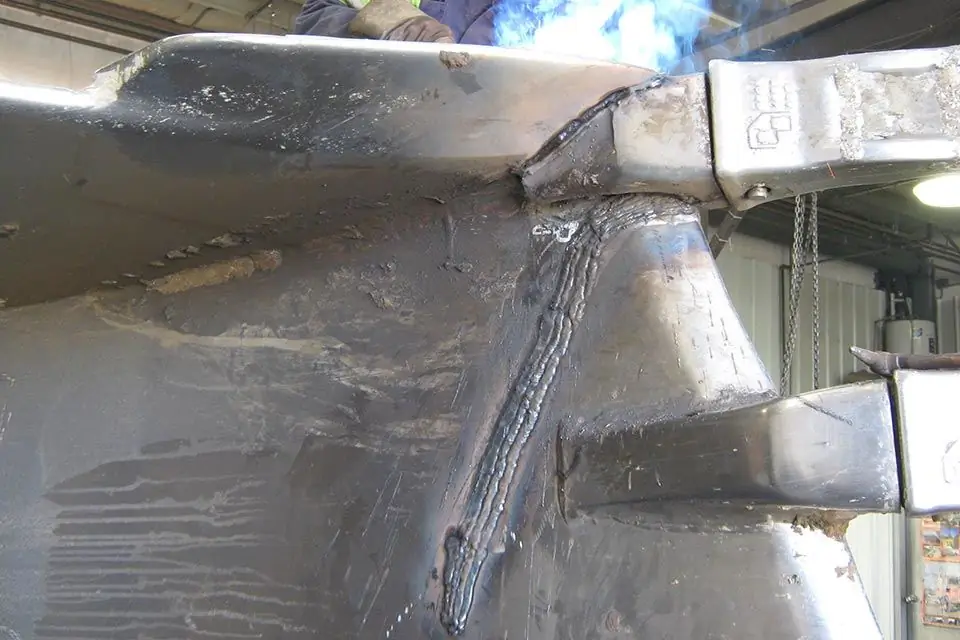2026 Author: Howard Calhoun | [email protected]. Last modified: 2025-06-01 07:12:56
Hydraulic fracturing (HF) is one of the most effective geological and technical measures, the purpose of which is to intensify the flow of formation fluid to production wells. The use of this technology allows not only to increase the recovery of reserves within the well drainage radius, but also to expand this area, increasing the ultimate oil recovery of the reservoir. Given this factor, field development design can be carried out with the arrangement of a sparser well pattern.
Short description

The essence of hydraulic fracturing is described by the following process:
- reservoir is subjected to excessive pressure (process fluid consumption is much greater than it can be absorbed by rocks);
- downhole pressure increases until it exceeds the internal stresses in the manifold;
- rocks are torn in the plane of least mechanical strength (most often in an oblique direction or vertically);
- againformed and old cracks increase, their connection with the natural pore system appears;
- a zone of increased permeability near the well increases;
- special granular proppants (proppants) are pumped into the expanded fractures to fix them in the open state after the pressure on the formation is removed;
- resistance to formation fluid movement becomes almost zero, as a result, the well flow rate increases several times.
The length of fractures in rocks can be several hundred meters, and the bottom of the well becomes connected with remote areas of the reservoir. One of the most important factors in the effectiveness of this treatment is the fixation of the crack, which allows you to create a filtration channel. However, well productivity cannot increase indefinitely as the fracture size increases. There is a maximum length, above which the flow rate does not become more intense.
Scope of application
This technology is used both for production (enhanced oil recovery) and injection (increased injectivity), horizontal and vertical wells. The following areas of application of hydraulic fracturing are distinguished:
- intensification of the flow rate of wells with a contaminated bottomhole zone in reservoirs with different permeability;
- development of heterogeneous deposits;
- improvement of the hydrodynamic connection of the well with the natural system of fractures in the reservoir;
- expansion of reservoir fluid inflow zone;
- development of reservoirs with low permeability andlow-margin wells;
- change in seepage flows in injection wells;
- restoration of well parameters that are not affected by other methods.
The limits for hydraulic fracturing technology are gas-oil zones, which are characterized by the following features:
- fast coning (pulling formation water to the bottom of the well);
- sudden breakthroughs of water or gas into the wellbore;
- depleted reservoirs with low reserves, oil-saturated lenses of small volume (due to economic unprofitability).
Most often hydraulic fracturing is used as a stimulation method for medium and high permeability reservoirs. For them, the main factor in increasing the inflow of reservoir fluid is the length of the formed fracture, and in deposits with low rock permeability, its width.
Hydraulic fracturing: advantages and disadvantages
The advantages of hydraulic fracturing are:
- applicable to areas with diverse geological structure;
- impact both on the entire reservoir and on its section;
- effective reduction of hydraulic resistance in the bottomhole zone;
- communion of poorly drained adjacent areas;
- cheap working fluid (water);
- high profitability.
Disadvantages include:
- the need for large supplies of water, sand, additional chemicals;
- uncontrolled process of creating a crack in the rock, unpredictability of the mechanismcracking;
- when wells with high flow rates are put into operation after hydraulic fracturing, proppant can be carried out of fractures, resulting in a decrease in the degree of their opening and a decrease in flow rate in the first months after the start of operation;
- risk of uncontrolled spouting and environmental pollution.
Process Variations

Fracturing methods differ in the type of fracture formation, the volume of fluid and proppants injected, and other characteristics. The main types of hydraulic fracturing include the following:
- According to the area of impact on the formation: local (fracture length up to 20 m) - the most widespread; deep penetrating (fracture length 80-120 m); massed (1000 m and more).
- By seam coverage: single (impact on all seams and interlayers); multiple (for wells that have opened 2 or more layers); interval (for a specific reservoir).
- Special methods: acid fracturing; TSO technology - formation of short fractures to prevent their propagation to the water-oil contact and reduce the volume of proppant injection (this method shows high efficiency in sandy reservoirs); impulse (creation of several radially diverging fractures in medium- and high-permeability rocks to reduce the skin effect - the deterioration of pore permeability due to their contamination with particles contained in the filtering formation fluid.
Multiplegap
Multiple hydraulic fracturing is performed by several methods:
- First, a crack is created using conventional technology. Then it is temporarily clogged by injecting substances (granular naphthalene, plastic balls, and others) that close the perforations. After that, hydraulic fracturing is done elsewhere.
- Separation of zones is carried out using packers or hydraulic gates. For each of the intervals, hydraulic fracturing is carried out according to the traditional scheme.
- Phased hydraulic fracturing with isolation of each underlying zone with a sand plug.
In clay sections, the most effective is the creation of vertical fractures, as they connect productive oil and gas interlayers. Such fractures are produced by the action of non-filterable fluids or by a rapid increase in injection rate.
Preparation for hydraulic fracturing
Hydraulic reservoir technology consists of several stages. The preparatory work is as follows:
- Study of the well for the formation fluid inflow, the ability to absorb the working fluid and determine the pressure required for hydraulic fracturing.
- Cleaning the bottomhole from sand or clay crust (washing with water under pressure, treatment with hydrochloric acid, hydro-sandblasting perforation and other methods).
- Checking the well with a special template.
- Descent into the wellbore pipes to supply the working fluid.
- Installation of pressure packer and hydraulic anchors to protect casing.
- Installation of wellheadequipment (manifold, lubricator and other devices) for connecting pumping units to injection pipelines and sealing the well.
Principal diagram of process equipment piping during hydraulic fracturing is shown in the figure below.

Fracturing sequence
Technique and technology of hydraulic fracturing consists of the following procedures:
- The injection pipes are supplied with a working fluid (most often oil for a production well or water for an injection well).
- Increase fracturing fluid pressure to maximum design value.
- Check the tightness of the packer (there should be no overflow of liquid from the annulus).
- The proppant is added to the working fluid after hydraulic fracturing occurs. This is judged by a sharp increase in well injectivity (pressure drop in the pumps).
- Radioactive isotopes are included in the last batch of proppant for subsequent verification of the loss zone using nuclear logging.
- Supply the highest pressure squeezing fluid for reliable crack propping.
- Removing the fracturing fluid from the bottom to ensure the inflow of formation fluid into the wellbore.
- Dismantle process equipment.
- The well is being commissioned.
If the well is relatively shallow, then the working fluid is allowed to be supplied through casing pipes. It is also possible to carry out hydraulic fracturing withoutpacker - through tubing pipes and annulus. This reduces hydraulic losses for highly viscous fluids.
Machines and mechanisms for hydraulic fracturing

Hydraulic fracturing equipment includes the following types of equipment:
- Ground machines and devices: pumping units (ANA-105, 2AN-500, 3AN-500, 4AN-700 and others); sand mixing plants on car chassis (ZPA, 4PA, USP-50, Kerui, Lantong and others); tank trucks for transportation of liquids (ATsN-8S and 14S, ATK-8, Sanji, Xishi and others); wellhead piping (manifold, wellhead, shutoff valves, distribution and pressure manifolds with check valves, pressure gauges and other equipment).
- Auxiliary equipment: aggregates for tripping operations; winches; monitoring and control stations; pipe trucks and other equipment.
- Underground equipment: packers to isolate the formation in which hydraulic fracturing is planned from another part of the production string; anchors to prevent lifting of underground equipment due to high pressure; tubing string.
The type of equipment and the number of pieces of equipment are determined based on the design parameters of hydraulic fracturing.
Design characteristics

The following basic formulas are used to calculate hydraulic fracturing:
- BHP (MPa) for hydraulic fracturing with filtered fluid: р=10-2KLc, where K is a coefficient selected from the range of values 1, 5-1, 8 MPa/m, L c - well length, m.
- Injection pressure of fluid with sand (for fracture propping): pp =p - ρgLc + p t, where ρ is the density of the sand carrier liquid, kg/m3, g=9.8 m/s2, p t - pressure loss due to friction of the sand-carrying fluid. The last indicator is determined by the formula: pt =8λQ2 ρLc/(πd B)2 B - tubing inner diameter.
- Number of pumping units: n=pQ/(ppQpKT) + 1, where pp is the operating pressure of the pump, Qp is its supply at a given pressure, KT- coefficient of the technical condition of the machine (selected within 0.5-0.8).
- Amount of displacement fluid: V=0, 785dB2Lc.
If hydraulic fracturing occurs using sand as a proppant, then its amount per 1 operation is assumed to be 8-10 tons, and the amount of fluid is determined by the formula:
V=QsCs, where Qs is the amount of sand, t, Cs - concentration of sand in 1 m3 liquid.
The calculation of these parameters is important, since at an excessively high pressure value during hydraulic fracturing, fluid is squeezed into the reservoir, accidents occur inproduction column. Otherwise, if the value is too low, the hydraulic fracturing will need to be stopped due to the inability to reach the required pressure.
Fracturing design is done as follows:
- Selection of wells according to the existing or planned field development system.
- Determination of the best fracture geometry, taking into account several factors: rock permeability, well grid, proximity to oil-water contact.
- Analysis of the physical and mechanical characteristics of rocks and the choice of a theoretical model for the formation of a crack.
- Determination of proppant type, amount and concentration.
- Selecting a fracturing fluid with suitable rheological properties and calculating its volume.
- Calculation of other technological parameters.
- Definition of economic efficiency.
Frac Fluids

Working fluids (displacement, fracturing and sand carrier) are one of the most important elements of hydraulic fracturing. The advantages and disadvantages of their various types are primarily related to rheological properties. If previously only viscous oil-based compositions were used (to reduce their absorption by the reservoir), then an increase in the power of pumping units has now made it possible to switch to water-based fluids with low viscosity. Due to this, the wellhead pressure and hydraulic resistance losses in the tubing string have decreased.
In world practice, the followingmain types of hydraulic fracturing fluids:
- Water with and without proppants. Its advantage is low cost. The disadvantage is the low depth of penetration into the reservoir.
- Polymer solutions (guar and its derivatives PPG, CMHPG; cellulose hydroxyethyl ether, carboxymethyl cellulose, xanthan gum). B, Cr, Ti, Zr and other metals are used for crosslinking molecules. In terms of cost, polymers belong to the middle category. The disadvantage of such fluids is the high risk of negative changes in the formation. Advantages include greater penetration depth.
- Emulsions consisting of a hydrocarbon phase (diesel fuel, oil, gas condensate) and water (mineralized or fresh).
- Hydrocarbon gels.
- Methanol.
- Thickened carbon dioxide.
- Foam systems.
- Foam gels, consisting of cross-linked gels, nitrogen or carbon dioxide foams. They have a high cost, but do not affect the quality of the collector. Other advantages are high proppant carrying capacity and self-destruction with little residual liquid.
To improve the functions of these compounds, various technological additives are used:
- surfactants;
- emulsifiers;
- fluid friction reducing joints;
- foamers;
- additives that change acidity;
- thermal stabilizers;
- bactericidal and anticorrosive additives and others.
The main characteristics of hydraulic fracturing fluids include:
- dynamic viscosity required to open a crack;
- infiltration properties that determine fluid loss;
- ability to carry proppant without it prematurely settling out of solution;
- shear and temperature stability;
- compatibility with other reagents;
- corrosive activity;
- green and safe.
Low-viscosity fluids require injection of a larger volume to achieve the required pressure in the reservoir, and high-viscosity fluids require more pressure developed by pumping equipment, since significant losses in hydraulic resistance occur. More viscous liquids are also characterized by lower filterability in rocks.
Propping Materials

The most commonly used proppants, or proppants, are:
- Quartz sand. One of the most common natural materials, and therefore its cost is low. Fixes cracks in various geological conditions (universal). The size of sand grains for hydraulic fracturing is selected 0.5-1 mm. The concentration in the sand carrier fluid varies between 100-600 kg/m3. In rocks characterized by strong fracturing, the consumption of material can reach several tens of tons per 1 well.
- Bauxite (aluminum oxide Al2O3). The advantage of this type of proppant is its greater strength compared to sand. Manufactured bycrushing and roasting bauxite ore.
- Zirconium oxide. It has properties similar to the previous type of proppant. Widely used in Europe. A common disadvantage of such materials is their high cost.
- Ceramic granules. For hydraulic fracturing, granules ranging in size from 0.425 to 1.7 mm are used. They belong to medium-strength proppants. Show high economic efficiency.
- Glass marbles. Previously used for deep wells, now almost completely replaced by cheaper bauxites.
Acid fracturing
The essence of acid hydraulic fracturing is that at the first stage a fracture is artificially created (just like in conventional hydraulic fracturing technology), and then acid is pumped into it. The latter reacts with the rock, creating long channels that increase the permeability of the reservoir in the bottomhole zone. As a result, the oil recovery factor from the well increases.
This type of hydraulic fracturing process is especially effective for carbonate formations. According to researchers, more than 40% of the world's oil reserves are associated with this type of reservoir. The technique and technology of hydraulic fracturing in this case differs slightly from those described above. The equipment is manufactured in acid-resistant design. Inhibitors (formalin, unikol, urotropin and others) are also used to protect machines from corrosion.
Types of acid fracturing are two-stage treatments using materials such as:
- polymer compounds (PAA, PVC, gipan andothers);
- latex compounds (SKMS-30, ARC);
- styrene;
- resins (BNI-5, TSD-9, TS-10).
As acidic solvents, a 15% hydrochloric acid solution is used, as well as special compositions (SNPKh-9010, SNPKh-9633 and others).
Types of acid fracturing are two-stage treatments using materials such as:
- polymer compounds (PAA, PVV, gipan and others);
- latex compounds (SKMS-30, ARC);
- styrene;
- resins (BNI-5, TSD-9, TS-10).
As acidic solvents, a 15% hydrochloric acid solution is used, as well as special compositions (SNPKh-9010, SNPKh-9633 and others).
Recommended:
Hydraulic system: calculation, scheme, device. Types of hydraulic systems. Repair. Hydraulic and pneumatic systems

The hydraulic system is a special device that works on the principle of a liquid lever. Such units are used in the braking systems of cars, in loading and unloading, agricultural machinery and even in the aircraft industry
Waste incineration plant: technological process. Waste incineration plants in Moscow and Moscow region

Waste incinerators have long been controversial. At the moment, they are the cheapest and most affordable way to recycle waste, but far from the safest. Every year, 70 tons of garbage appears in Russia, which needs to be removed somewhere. Factories become a way out, but at the same time the Earth's atmosphere is exposed to enormous pollution. What waste incineration plants exist and is it possible to stop the waste epidemic in Russia?
What is a technology project? Development of a technological project. Example of a technological project

As part of the article, we will find out what a technological project is, and also work out the issues of its development
Hydraulic calculation of heat networks: concept, definition, calculation method with examples, tasks and design

It can be said that the purpose of the hydraulic calculation of the heat network at the end point is the fair distribution of heat loads between the subscribers of thermal systems. A simple principle applies here: each radiator, if necessary, that is, a larger radiator, which is designed to provide a larger volume of space heating, should receive a larger flow of coolant. This principle can be ensured by the correct calculation
Restoration of parts by welding and surfacing: methods and methods of restoration, features, technological process

Welding and surfacing technologies allow efficient restoration of metal parts, providing a high degree of reliability and durability of the product. This is confirmed by the practice of using these methods when performing repair operations in a variety of areas - from car repairs to the production of rolled metal. In the total amount of work on the repair of metal structures, the restoration of parts by welding and surfacing takes about 60-70%

